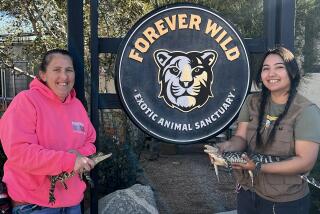Boy’s Killing by Alligator a Message for Florida : Reptiles thrived in the state for millions of years and recently recovered. Accident prompts some calls to curb them.
- Share via
MIAMI — Long before Disney World, eons before the first luxury hotel went up on Miami Beach, and millions of years, in fact, before the first humans arrived, Florida was rich in a wilderness of wetlands that was prime habitat for alligators.
And it still is.
Nonetheless, many in Florida are still reeling today from a brutal reminder of that natural fact five days after a 10-year-old boy on an outing with his parents and his Little League baseball team was attacked and killed by a 400-pound alligator.
The death of Bradley Weidenhamer in a state park just north of West Palm Beach was only the sixth alligator fatality in Florida since 1972, but in recent years there have been scores of injuries to humans and reports of pets eaten by a reptile that has made a remarkable recovery after being hunted to near-extinction in the late 1960s.
After being placed on the federal endangered species list in 1970, alligators have thrived. The state alligator population is now estimated at more than 1 million--roughly one for every 13 residents--and each year Florida licenses hunters to kill up to 2,800 of the reptiles.
The attack last week has spurred some calls for alligators to be eliminated from Florida’s more popular parks and even driven out of the vast canal system that has dried out millions of acres of wetlands and opened much of South Florida to human habitation in the first place.
But that, say state officials, will not happen.
“This is a tragedy; it’s terrible,” said Mark Glisson of the Florida Department of Natural Resources in Tallahassee. “I’d do anything to get this kid back.
“But Florida is full of alligators, and the suggestion that we should remove them distresses me considerably. We don’t want to punish the messenger . . . and the message is: The alligator lives here, and we humans don’t run the show.”
Bradley died without warning on Saturday afternoon on the Loxahatchee River in a park that offers one of Florida’s most scenic and popular canoe trails. He had been paddling along the slow-moving river--with a group of friends and Little League teammates in about 20 rented canoes--when he stepped out of the boat he was sharing with his mother and father after it ran up against a fallen tree.
Wearing shorts and a T-shirt, he was standing in knee-deep water when a male alligator more than 11 feet long grabbed him, pulled him under the water and then clamped his powerful jaws over the boy’s head.
In a tearful, wrenching press conference Sunday, the day after the attack, Bradley’s father, Gary Weidenhamer, described how he tried to wrest his son free of the reptile’s jaws. “I grabbed a foot and just pulled as hard as I could,” said Weidenhamer, a high school chemistry teacher in Lake Worth.
Weidenhamer said that he struggled for about three minutes as others beat the alligator with their paddles, before his son was freed. He immediately administered CPR, without success.
Florida Game and Fresh Water Fish Commission officers found the alligator, known to park personnel as Big John, and shot it to death.
A comparison of the reptile’s teeth with the boy’s wounds confirmed it as the killer. A necropsy also found that the animal’s stomach was empty and that the alligator was about 100 pounds underweight.
Nothing, biologists say, will ever explain why that alligator attacked Bradley when it did. In fact, the risks of being bitten by an alligator are slim. Florida’s six deaths in 11 years are the only ones reported in the United States. According to statistics in recent issues of the Journal of the American Medical Assn. and the Wildlife Society Bulletin, in the United States each year 12 people die of rattlesnake bites, 40 from bee stings, three from black widow spiders and 18 to 20 from dog bites. Eighty-six people are killed each year by lightning.
Although alligators are now found across the Southeast, from Texas to the Carolinas, no state has more than Florida. And in the last 20 years, no deaths have been reported anywhere but in Florida, state biologist Dennis David said.
Despite the alarm caused by Saturday’s attack, David and other wildlife experts said the balance between alligators and humans is about right.
The state operates a toll-free “nuisance alligator” hot line over which it receives 8,000 to 10,000 calls a year, leading to the capture and killing of about 4,000 alligators from back yards, neighborhood lakes and urban canals, David said.
He added: “The remaining animals are pretty safe if you leave them alone. Use common sense.”
More to Read
Sign up for Essential California
The most important California stories and recommendations in your inbox every morning.
You may occasionally receive promotional content from the Los Angeles Times.










